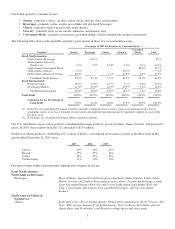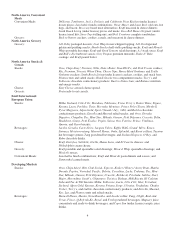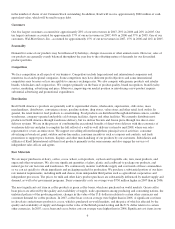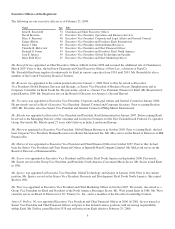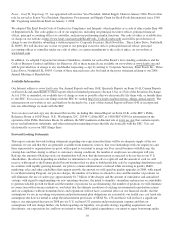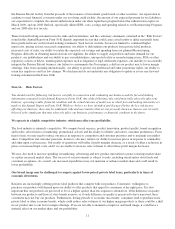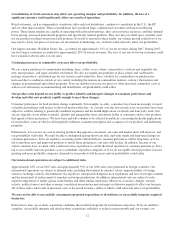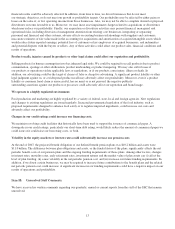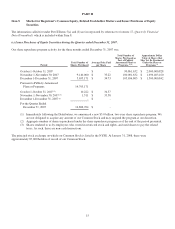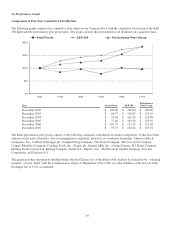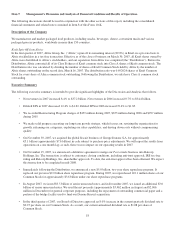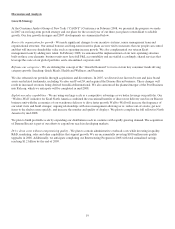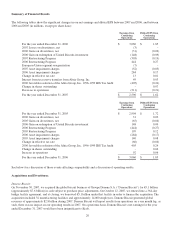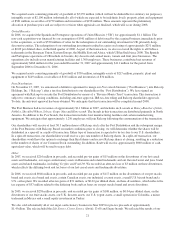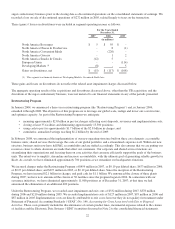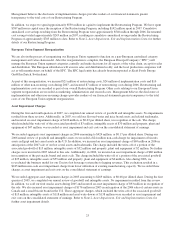Kraft 2007 Annual Report Download - page 28
Download and view the complete annual report
Please find page 28 of the 2007 Kraft annual report below. You can navigate through the pages in the report by either clicking on the pages listed below, or by using the keyword search tool below to find specific information within the annual report.financial results could be adversely affected. In addition, from time to time, we divest businesses that do not meet
our strategic objectives, or do not meet our growth or profitability targets. Our profitability may be affected by either gains or
losses on the sales of, or lost operating income from those businesses. Also, we may not be able to complete desired or proposed
divestitures on terms favorable to us. Moreover, we may incur asset impairment charges related to acquisitions or divestitures
which may reduce our profitability. Finally, our acquisition or divestiture activities may present financial, managerial and
operational risks, including diversion of management attention from existing core businesses, integrating or separating
personnel and financial and other systems, adverse effects on existing business relationships with suppliers and customers,
inaccurate estimates of fair value made in the accounting for acquisitions and amortization of acquired intangible assets which
would reduce future reported earnings, potential loss of customers or key employees of acquired businesses, and indemnities
and potential disputes with the buyers or sellers. Any of these activities could affect our product sales, financial conditions and
results of operations.
Product recalls, injuries caused by products or other legal claims could affect our reputation and profitability.
Selling products for human consumption involves inherent legal risks. We could be required to recall products due to product
contamination, spoilage or other adulteration, product misbranding or product tampering. We may also suffer losses if
our products or operations violate applicable laws or regulations, or if our products cause injury, illness or death. In
addition, our advertising could be the target of claims of false or deceptive advertising. A significant product liability or other
legal judgment against us, or a widespread product recall may adversely affect our profitability. Moreover, even if a product
liability or consumer fraud claim is unsuccessful, has no merit or is not pursued, the negative publicity
surrounding assertions against our products or processes could adversely affect our reputation and brand image.
We operate in a highly regulated environment.
Food production and marketing are highly regulated by a variety of federal, state, local and foreign agencies. New regulations
and changes to existing regulations are issued regularly. Increased governmental regulation of the food industry, such as
proposed requirements designed to enhance food safety or to regulate imported ingredients, could increase our costs and
adversely affect our profitability.
Changes in our credit ratings could increase our financing costs.
We maintain revolving credit facilities that historically have been used to support the issuance of commercial paper. A
downgrade in our credit ratings, particularly our short-term debt rating, would likely reduce the amount of commercial paper we
could issue or it could raise our borrowing costs, or both.
Volatility in the equity markets or interest rates could substantially increase our pension costs.
At the end of 2007, the projected benefit obligation of our defined benefit pension plans was $10.2 billion and assets were
$11.0 billion. The difference between plan obligations and assets, or the funded status of the plans, significantly affects the net
periodic benefit costs of our pension plans and the ongoing funding requirements of those plans. Among other factors, changes
in interest rates, mortality rates, early retirement rates, investment returns and the market value of plan assets can (i) affect the
level of plan funding; (ii) cause volatility in the net periodic pension cost; and (iii) increase our future funding requirements. In
addition, if we divest certain businesses, we may be required to increase future contributions to the benefit plans and the related
net periodic pension cost could increase. A significant increase in our funding requirements could have a negative impact on our
results of operations and profitability.
Item 1B. Unresolved Staff Comments.
We have received no written comments regarding our quarterly, annual or current reports from the staff of the SEC that remain
unresolved.
13


